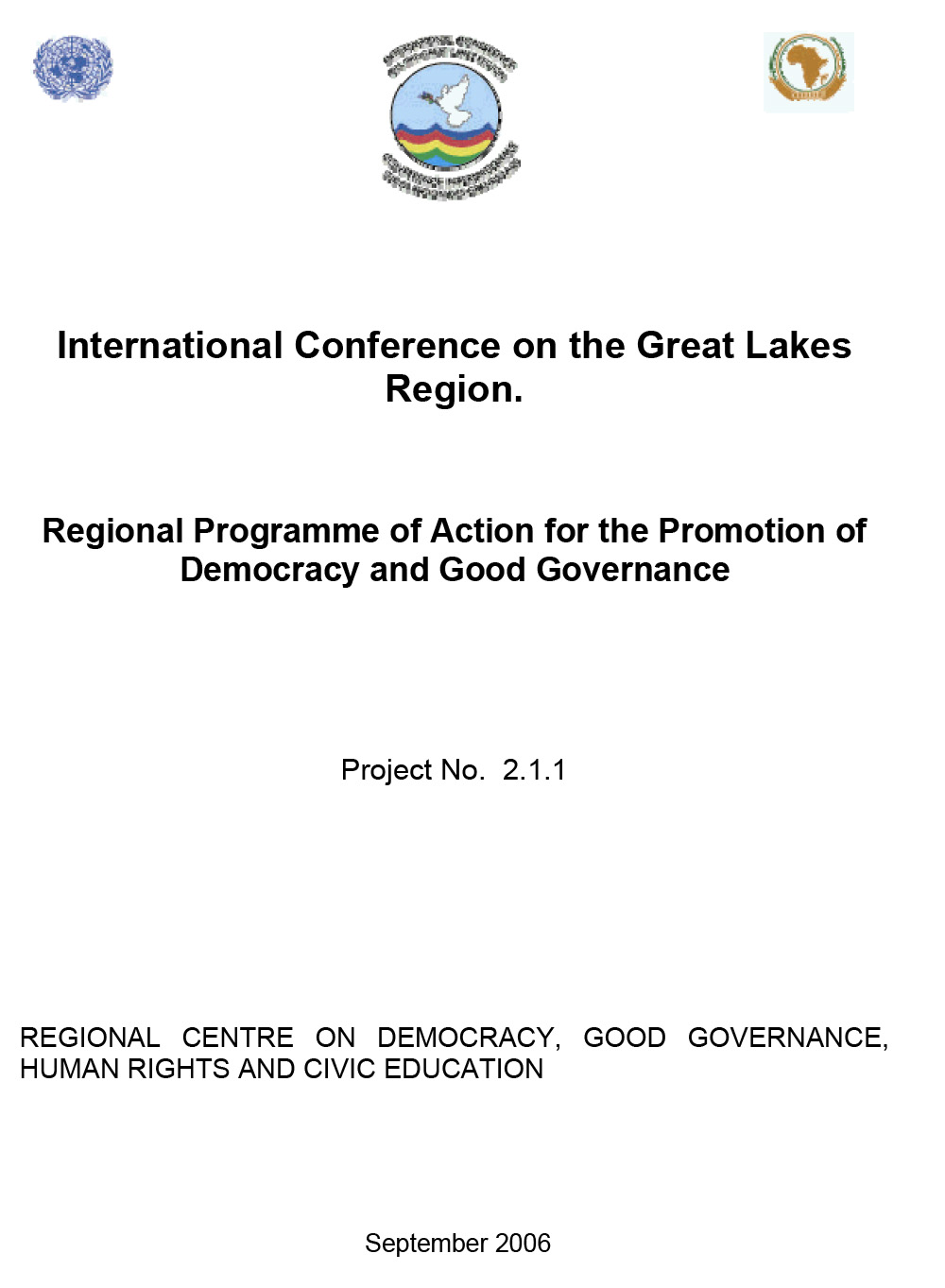Democracy And Good Governance
OUR ENGAGEMENT:
The Heads of State and Government of Member States of the International Conference on the Great Lakes Region during the signing of the Pact on Security, Stability and Development in the Great Lakes Region, committed to entrench values, principles and norms on democracy, good governance and respect for human rights in the framework of Programme of Action for Democracy and Good Governance in order to:
- Establish regional mechanisms which work together to strengthen the rule of law in the region, to promote human rights and combat impunity.
- Consolidate the democratization process by enhancing institutional capacity, by promoting political participation of all segments of society, and by developing and implementing communication and information strategies.
- Harmonize and coordinate policies on the protection and rational management of natural resources in the region.
OUR CONTENT:
The Regional Action Program on the Promotion of Democracy and Good Governance comprises three sub-programs and three protocols. The sub-programs are the following:
- The regional Forum parliamentarians;
- The Forum for women
- the Multi-purpose youth forum
- The consultative committee on vulnerable Groups
- The Forum for civil Society
- The management of information and communication
Which comprises the Régional Initiative on the fight against the Illegal Exploitation of Natural Resources comprised of the Six Tools as adopted by the Special Summit of ICGLR Heads of State and Government in Lusaka, Zambia in December 2010. The Six Tools are as follows:
- Regional Certification Mechanism
- Harmonization of National Legislations
- Regional Database on Mineral Flows
- Formalization of the Artisanal and Small-Scale Mining (ASM) Sector

Protocol Against illegal exploatation of natural resources

Protocol for the prevention of the punishmentand the crime of genocide, war crime and crimes against humanity and all forms of discrimination

Protocol and democracy and good governence

Protocol on judicial cooperation

Protocol on management of information and communication

Protocal on the specific reconstruction and Development zone (SRDZ)

Protocol on non aggression and mutual Defence in great Lakes Region

Protocal on the protection and assistance to internally displaced persons

Overview of the ICGLR Regional initiative on the fight against the illegal exploitation of Natural resources

Protocol on non aggression and mutual Defence in great Lakes Region

Protocal on the protection and assistance to internally displaced persons

Overview of the ICGLR Regional initiative on the fight against the illegal exploitation of Natural resources

The Pact on security, stability and Development for the Great Lakes Region

Protocol on the property Rights of returning persons
OUR PROJECTS AND PARTENERS:
Demining and mine action in the great lakes region
The conflict scenario that has characterized the member countries of the IC/GLR during the last decade or so, has ‘endowed’ these countries with a common legacy. The confrontations between the different armed groups, both government and rebel groups, elicited use of landmines, with anti-personnel mines (APMs) being the favorite due to its easy availability, cheapness and portability among other attributes, including its ‘trustworthiness’ and ‘loyalty as a silent sentinel’. Due to these attributes an APM became a ‘weapon of choice’ for the opposing armed parties. The intra-country conflicts had spill-over effect into neighboring countries, and drew the neighbors into the internal confrontations. Subsequently, large swathes of the fields of all IC/GLR countries are littered with APMs, MOTAPMs and other explosive remnants of war (ERW).
Key Partners: SUA/TPDF,IMATC National Mine authorities/GICHD, NMA, GICHD, Mine clearance NGO’s , Public Health authorities/ ICGLR , DOTS, APOPO
![]() Download: Demining and mine action in the great lakes region
Download: Demining and mine action in the great lakes region
Development of border zones and promotion of human security
Border zones continue to constitute threats to the region, states and communities of the GLR. Core in these are cross border attacks by armed groups and bands of cattle rustlers, smuggling, motor vehicle thefts, drug trafficking, flows of small arms and now threats of terror networks. The foregoing has transformed borders into crush points of conflicts. Underlying this are several factors: The border spaces are made ideal by existing obstacles to accessibility (terrain, forests, deserts). They constitute ideal sanctuaries on either side of the frontiers.
Key Partners: Member States, DRC Gov, MONUC, AU and Tri-Partite Plus, UNHCR, OCHA, NGOs
![]() Download: Development of border zones and promotion of human security
Download: Development of border zones and promotion of human security
Demining and mine action in the great lakes region
The conflict scenario that has characterized the member countries of the IC/GLR during the last decade or so, has ‘endowed’ these countries with a common legacy. The confrontations between the different armed groups, both government and rebel groups, elicited use of landmines, with anti-personnel mines (APMs) being the favorite due to its easy availability, cheapness and portability among other attributes, including its ‘trustworthiness’ and ‘loyalty as a silent sentinel’. Due to these attributes an APM became a ‘weapon of choice’ for the opposing armed parties. The intra-country conflicts had spill-over effect into neighboring countries, and drew the neighbors into the internal confrontations. Subsequently, large swathes of the fields of all IC/GLR countries are littered with APMs, MOTAPMs and other explosive remnants of war (ERW).
Key Partners: Development partners, UN, ADB Special Fund, Development Partners for funding
![]() Download: Disarmament and Repatriation of All Armed Groups in Eastern DRC
Download: Disarmament and Repatriation of All Armed Groups in Eastern DRC

